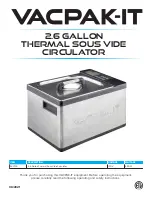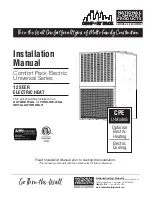
Use the mounting base ring to mark the screw
holes on the ceiling or the wall.
Once the mounting base is installed, attach the
alarm by twisting clockwise until it clicks. If
the switch is in ‘Learn Mode’, the heat alarm will
not be able to click into the mounting base.
6. SAFETY LOCK:
7. TEST FUNCTION:
After installation, and at least once per quarter,
test all of your alarms to ensure they are operating
correctly and are within range of each other.
It is recommended to check visually every week if
the LED flashes correctly (every 48sec.)
Press the test button on any alarm for 2
sweeps of alarm signal. This will send out a
test signal from the alarm; all other connected
alarms should receive the signal within a short
time. The alarms will emit a short beep and the
LED will flash every 8 seconds for 2 minutes.
NOTE: Test function also allows to send a depleted
RF signal to ensure an optimal operation in normal
conditions.
When the test signal is sent out, the alarms will
respond in two ways:
1. A single beep every 8 seconds indicates that the
alarms are connected and functioning.
2. Three short beeps every 8 seconds indicates a
heat sensor fault.
If required this indication can be stopped early on
each alarm by a short press of the test button.
If the problem continues, please visit www.cavius.
com for any trouble shooting.
8. ADD EXTRA DEVICE:
All CAVIUS interconnected alarms within the
they run on the same frequency and use the same
data protocol.This means that the wireless system
can consist of a combination of smoke, heat etc.
Place all alarms into ‘Learn Mode’ and repeat
section 1.
Always test connection to all devices by repeating
test function section 7 after adding devices.
The alarm effected by the low battery will only
beep, no other connected alarms will sound.
9. OTHER INFORMATION:
Do not paint the alarm.
Disposal: Please dispose properly at the end of
life. This is electronic waste which should be re-
cycled.
The heat alarm is not suitable for use as a fire
safety device unless it is part of a planned fire
safety system, i.e. when interconnected to one or
more smoke alarm(s).
Complies to the Radio Equipment Directive
2014/53/EU
RF frekvens: 868 MHz.
Maximum radio-frequency power transmitted: 20
dBm
Full DoC to 2014/53/EU (RED) can be download-
ed at www.cavius.com
WARNING: All alarms should be assumed as due
to actual fire and the dwelling should be evacuat-
ed immediately.
WARNING: To prevent injury, this apparatus must
be securely attached to the ceiling/wall in accor-
dance with the installation instructions.
WARNING: Batteries shall not be exposed to ex-
cessive heat such as shine, fire, or the like.
Note the local country regulations regarding
installation.
The CE mark affixed to this product confirms its
compliance with the European Directives which
apply to the product.
Tested to comply to the standard of system heat
alarms EN54-5 class A1.
Alarm condition aural signal pattern according to
ISO 8201.
BSI Kitemark™ certified.
All Rights reserved: Cavius Aps assumes no
responsi bility for any errors, which may appear
in this manual. Furthermore, Cavius Aps reserves
the right to alter the hardware, software, and/or
specifications detailed herein at any time without
notice, and Cavius Aps does not make any
commitment to update the infor mation contained
herein. All the trademarks listed herein are owned
by their respective owners. Copy right © Cavius Aps.
Developed by CAVIUS Aps Jens Juuls Vej 28 K,
DK-8260
Manufactured in P.R.C.
Contact: CAVIUS Ltd, Edinburgh, Scotland, EH3
9DQ
[email protected]. www.cavius.com
400147 rev4
CLICK THE HEAT ALARM
FIRMLY INTO THE BASE
TO LOCK
HEAT ALARM
SMOKE ALARM
MAINS POWERED
SMOKE ALARM
MAINS POWERED
HEAT ALARM
USE THE
ENCLOSED
SCREWS AND
PLUGS
MOUNT THE
SAFETY LOCK
BS 5446-2:2003
A1 3106-008
KM 737251




















